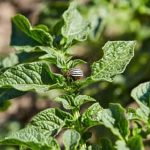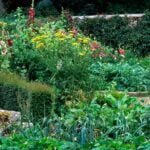Vegetable gardens are a source of fresh, nutritious produce that many people enjoy. However, they are also vulnerable to garden pests that can wreak havoc on these prized plants. Pest control becomes essential in maintaining the health and productivity of vegetable gardens. One pesticide that is often used for this purpose is Sevin, but the safety of using it in vegetable gardens has been a topic of concern.
In this article, we will explore the question “Is Sevin safe for vegetable gardens?” and provide an in-depth analysis of its potential risks and benefits. Before delving into the specifics of Sevin, it is crucial to understand the importance of pest control in vegetable gardens. Garden pests can destroy crops, transmit diseases, and compromise food safety. Therefore, finding effective methods to manage these pests is vital for gardeners.
Next, we will introduce Sevin and explain how it works in controlling garden pests. As one of the most widely used pesticides worldwide, Sevin has gained popularity due to its broad-spectrum activity against numerous pests. We will delve into its mode of action and highlight its effectiveness in curbing garden infestations. Understanding how Sevin works will set the stage for evaluating its safety and suitability for vegetable gardens.
Explaining Sevin
Sevin, also known as carbaryl, is a widely used insecticide that is commonly used in vegetable gardens to control various pests. It belongs to a class of chemicals called carbamates and works by inhibiting the nervous system of insects, ultimately leading to their death.
What is Sevin?
Sevin is available in various formulations including liquid concentrate, dust, and granules. It can be applied using sprayers or spreaders depending on the specific needs of your vegetable garden. The active ingredient in Sevin, carbaryl, is effective against a wide range of common garden pests such as aphids, beetles, caterpillars, and mites.
How Does it Work in Controlling Garden Pests?
When Sevin comes into contact with pests, it disrupts the proper functioning of their nervous systems by inhibiting the enzyme acetylcholinesterase. This enzyme is responsible for transmitting nerve impulses throughout an insect’s body. By blocking this enzyme, Sevin essentially paralyzes the pest and causes its death through a process known as cholinesterase inhibition.
Moreover, Sevin has both contact and systemic activity. Contact activity means that the insecticide kills pests upon direct contact with them. Systemic activity refers to the ability of Sevin to be absorbed by plants after application and then move through their vascular system. This systemic movement helps protect both foliage and fruits from insects that feed on them.
It is important to note that while Sevin is effective against a broad spectrum of pests, it may also harm beneficial insects such as bees and ladybugs if not used properly. So always follow the instructions provided by the manufacturer for safe and effective use.
Evaluating the Safety of Sevin in Vegetable Gardens
As gardeners, it is natural to have concerns about the safety of using chemical pesticides like Sevin in our vegetable gardens. After all, we want to ensure that we are not only protecting our crops from pests but also safeguarding our health and the environment. In this section, we will address some common concerns and debunk myths surrounding the safety of Sevin in vegetable gardens.
One common concern is whether Sevin residue can remain on vegetables after application, making them unsafe to consume. It is important to note that when applied properly, Sevin breaks down relatively quickly in the soil and does not persist for an extended period. In fact, studies have shown that residues typically degrade within a few days to weeks, depending on various factors such as weather conditions and application rates.
Another myth that needs debunking is that Sevin poses a risk to beneficial insects or pollinators. While it is true that Sevin can be toxic to insects if ingested or if they come into direct contact with it during spraying, when used responsibly according to labeling instructions, the impact on non-target organisms can be minimized. To further protect beneficial insects and pollinators, it is recommended to avoid applying pesticides during flowering periods or when these organisms are most active.
Furthermore, some gardeners may worry about potential health risks associated with using Sevin in their vegetable gardens. The United States Environmental Protection Agency (EPA) evaluates these products for safety before granting their approval for use. When used according to label directions and dose rates specified by the manufacturer, Sevin has been determined safe for gardeners when handling and using correctly.
Understanding the Potential Risks
Sevin, a commonly used pesticide for controlling garden pests in vegetable gardens, raises concerns about its potential risks. In this section, we will analyze the chemical composition of Sevin and its environmental impact to shed light on these concerns.
Firstly, it is important to understand that the active ingredient in Sevin is carbaryl. Carbaryl belongs to the chemical class known as carbamates and has been widely used as an insecticide since the 1950s. It works by disrupting the nervous system of insects, leading to their paralysis and eventual death.
However, due to its mode of action, there are potential risks associated with the use of Sevin. These risks include harm to beneficial insects such as bees and other pollinators if they come into contact with the pesticide while foraging on flowers treated with Sevin. It is crucial to avoid applying Sevin during times when bees are most active, such as during flowering periods.
Additionally, carbaryl can also be toxic to aquatic organisms if it enters water bodies through runoff or drift. Care must be taken when using Sevin near water sources or areas prone to runoff.
To assess the environmental impact of Sevin, studies have been conducted on its persistence in soils and water systems. Research suggests that while carbaryl can persist in soil for several weeks or months depending on factors such as soil type and pH, it generally degrades over time. However, caution should still be exercised when using Sevin repeatedly in the same area as it could lead to accumulation in soil and potentially affect non-target organisms.
Table: Chemical Composition of Sevin
| Chemical | Percentage Concentration |
|---|---|
| Carbaryl | 5% |
| Inert Ingredients | 95% |
Examining the Appropriate Use
Before deciding to use Sevin in your vegetable garden, there are several factors that should be taken into consideration. Understanding these factors will help you make an informed decision about whether or not Sevin is appropriate for the specific needs of your garden.
- Identify the Pest Problem: The first step in determining if Sevin is the right solution for your vegetable garden is to identify the specific pests that you are dealing with. Sevin is most effective against a wide range of insects, including beetles, aphids, and leafhoppers. If your pest problem consists of a different type of insect or if you are dealing with a disease instead of insects, Sevin may not be the best choice.
- Consider the Vegetables Being Grown: Different vegetables have varying sensitivities to pesticides, so it’s important to consider this when deciding whether or not to use Sevin. Some vegetables, such as tomatoes and peppers, have been found to be more tolerant of Sevin than others. On the other hand, leafy greens like lettuce and spinach may be more sensitive to pesticide applications and require more caution when using Sevin.
- Assess Environmental Factors: It’s crucial to take into account the surrounding environment before applying any pesticide in your vegetable garden. Consider factors such as nearby water sources (e.g., ponds, streams) and neighboring plants that could potentially be impacted by overspray or runoff from using Sevin. Additionally, if your garden is located near areas frequented by children or pets, extra precautions should be taken to ensure their safety.
Considering these factors can help determine whether or not Sevin is an appropriate solution for controlling pests in your vegetable garden. However, it’s always advisable to explore alternative pest control methods that are organic and non-toxic before resorting to chemical options like Sevin.
Alternative Pest Control Methods
Introduction to Alternative Pest Control Methods
While Sevin may be a popular choice for controlling pests in vegetable gardens, many gardeners are increasingly seeking organic and non-toxic alternatives. These alternatives not only prioritize the health and safety of both humans and the environment but also promote sustainable gardening practices. In this section, we will explore some effective pest control methods that do not rely on Sevin or other chemical pesticides.
Cultural Practices
One of the most basic and often overlooked methods of pest control is through cultural practices. By implementing certain strategies in your vegetable garden, you can create an environment that is less attractive to pests. Crop rotation, for example, involves changing the location of specific plants each year to disrupt pest life cycles. This reduces the likelihood of recurring infestations.
Another cultural practice is companion planting, which involves planting certain plants together to deter pests naturally. For instance, marigolds are known to repel aphids and nematodes when planted alongside vegetables like tomatoes and peppers. Additionally, promoting biodiversity by including a variety of different plants in your garden can attract beneficial insects such as ladybugs and lacewings that feed on common garden pests.
Biological Controls
Biological controls involve utilizing living organisms to control pests naturally. This method can be particularly effective in managing insect populations without resorting to chemical pesticides. One common biological control method is introducing beneficial insects into your garden. Ladybugs, for example, are voracious predators of aphids and can help reduce their numbers significantly.
Nematodes are another example of a biological control tool that targets specific pests like slugs or caterpillars by releasing microscopic worms into the soil where they infect and kill their hosts. Using biological controls requires careful research and consideration as different pests may require specific organisms for effective management. It’s essential to ensure that the beneficial insects or organisms you introduce are compatible with your garden ecosystem.
Organic Insecticidal Sprays
For times when pest populations become overwhelming, organic insecticidal sprays can be an effective short-term solution. These sprays are derived from natural sources such as plant oils or soaps and are formulated to target specific pests while being less harmful to beneficial insects and the environment. Pyrethrin, for example, is a botanical insecticide derived from chrysanthemum flowers that effectively targets a wide range of garden pests.
Neem oil is another popular organic spray that acts as both an insecticide and fungicide. It disrupts the feeding and breeding behavior of pests, ultimately leading to their demise. When using organic insecticidal sprays, it’s important to carefully follow the instructions on the label and avoid applying during peak pollination periods to protect bees and other pollinators.
By exploring these alternative pest control methods, gardeners can reduce their reliance on chemical pesticides like Sevin and incorporate more sustainable practices into their vegetable gardens. However, it’s important to keep in mind that each garden is unique, and experimentation may be required to find the most effective combination of techniques for your specific pest challenges.
Tips for Using Sevin Safely in Vegetable Gardens
Using Sevin safely in vegetable gardens is crucial to minimize risks and ensure the health of both your plants and yourself. While Sevin can be an effective pest control option, it is important to follow best practices and take necessary precautions when using this chemical.
One of the first tips for using Sevin safely in vegetable gardens is to carefully read and follow the instructions provided on the product label. The label will include important information on proper application rates, timing, and safety precautions. It is essential to adhere to these guidelines to ensure the effectiveness of Sevin while minimizing any potential risks.
Another important practice is to wear suitable protective clothing and gear when applying Sevin. This may include long sleeves, gloves, goggles, and a mask. These protective measures will help prevent direct contact with the chemical and reduce the risk of skin irritation or inhalation.
It’s also crucial to consider the timing of Sevin application in vegetable gardens. Applying the product in the early morning or late evening when pollinators are less active can help minimize harm to bees and other beneficial insects. Additionally, it is advisable to avoid applying Sevin on windy days to prevent drift onto non-target areas.
In summary, here are some best practices and precautions for using Sevin safely in vegetable gardens:
- Read and follow all instructions on the product label.
- Wear appropriate protective clothing and gear.
- Time your application when pollinators are less active.
- Avoid applying Sevin on windy days.
By following these tips, you can use Sevin effectively while reducing potential risks in your vegetable garden.
| Best Practices | Precautions |
|---|---|
| Read and follow all instructions on the product label. | Wear appropriate protective clothing and gear. |
| Time your application when pollinators are less active. | Avoid applying Sevin on windy days. |
Case Studies and Success Stories
When it comes to using pesticides like Sevin in vegetable gardens, many gardeners are interested in hearing about the real-life experiences of others. Case studies and success stories can provide valuable insights and practical tips for those considering the use of Sevin in their own gardens. In this section, we will explore some examples of gardeners who have used Sevin successfully in their vegetable gardens.
1. John’s Tomato Patch:
John, a passionate gardener from California, faced a severe infestation of tomato hornworms in his vegetable garden. After trying various organic methods without much success, he decided to use Sevin according to the recommended instructions. Within days, he noticed a significant reduction in the number of pests on his tomato plants. The tomatoes ripened beautifully, thanks to effective pest control by Sevin.
2. Mary’s Cabbage Farm:
Mary runs a small-scale cabbage farm in Oregon. She had been struggling with persistent attacks from cabbage loopers that caused extensive damage to her crops. As a last resort, she decided to give Sevin a try after consulting with local agricultural experts.
Mary carefully applied Sevin only where necessary and observed that the cabbage loopers were quickly controlled without damaging beneficial insects or pollinators. Mary was able to harvest healthy cabbages at the end of the season, ensuring her farm’s profitability.
3. Michael’s Zucchini Garden:
Michael encountered an unexpected outbreak of squash bugs that were threatening his zucchini plants in Texas. After reading about other gardeners’ success with Sevin online, he cautiously applied it around his zucchini plants as directed on the label and took steps to protect bees during application.
Not only did Michael experience excellent control over squash bugs within days but also witnessed minimal impact on pollinator populations such as honeybees, which played a vital role in his vegetable garden’s overall health.
These case studies highlight the positive experiences of gardeners who have used Sevin effectively in their vegetable gardens. However, it is essential to remember that results may vary depending on factors such as pest species, geographic location, weather conditions, and application techniques. Before using Sevin or any other pesticide, it is always recommended to consult with local gardening experts or extension services for personalized advice based on your specific circumstances.
Conclusion
In conclusion, when it comes to using Sevin in vegetable gardens, it is important to make an informed decision. While Sevin can be effective in controlling garden pests, there are potential risks and environmental impacts that need to be considered. It is crucial to evaluate the safety of Sevin, understand its chemical composition, and assess its potential effects on the environment before deciding to use it.
Additionally, alternative pest control methods should also be explored. Organic and non-toxic alternatives to Sevin can provide an effective and safer solution for pest control in vegetable gardens. These alternatives include the use of natural predators, biological controls, companion planting, and organic pesticides.
When using Sevin in vegetable gardens, it is essential to follow best practices and take necessary precautions to minimize risks. This includes carefully reading and following the instructions on the product label, wearing appropriate protective clothing during application, and avoiding direct contact with skin or eyes. It is also advisable to apply Sevin during calm weather conditions to prevent drift onto non-target plants or areas.
Lastly, it can be helpful to learn from the experiences of other gardeners who have used Sevin in their vegetable gardens. Case studies and success stories provide valuable insights into the effectiveness and potential risks associated with using this pesticide. By considering these real-life experiences along with all the available information, gardeners can make a well-informed decision about whether or not to use Sevin in their vegetable gardens.
Ultimately, the decision about whether or not to use Sevin in a vegetable garden should be based on a thorough understanding of its safety concerns, environmental impacts, alternative options, best practices for usage, and the experiences of other gardeners. By weighing all these factors carefully, individuals can ensure that they are making choices that prioritize both pest control effectiveness and garden health.
Frequently Asked Questions
Can you eat vegetables after spraying with Sevin?
While it is not recommended to eat vegetables immediately after spraying with Sevin, there are guidelines provided by the manufacturer regarding the waiting period before consuming treated crops. Sevin contains carbaryl, which is an insecticide that can be harmful if ingested in high amounts.
It is important to follow the instructions on the product label and wait for the specified amount of time before consuming any vegetables that have been treated with Sevin. This waiting period allows for the chemical to break down and disperse, reducing potential exposure to humans.
Can you eat tomatoes sprayed with Sevin?
Similar to other vegetables, it is advisable to wait for a specific duration after spraying tomatoes with Sevin before eating them. Since Sevin may contain carbaryl as its active ingredient, it is essential to adhere to the recommendations provided by the manufacturer to ensure safety.
Follow the instructions on the product label carefully regarding application rates, timing, and pre-harvest intervals. Waiting for this designated period allows for any remaining traces of Sevin or its residue on tomatoes to degrade or dissipate, minimizing potential risks associated with ingestion.
How toxic is Sevin to humans?
The toxicity of Sevin (carbaryl) varies depending on factors such as dosage, exposure route, duration of exposure, and individual susceptibility. Carbaryl is classified as a moderately toxic pesticide by various regulatory agencies worldwide due to its potential adverse effects on human health if misused or overexposed. Short-term exposure may result in symptoms like irritation of the skin or eyes, nausea, dizziness, headaches, and respiratory distress in severe cases.
Prolonged or repeated exposure can pose increased risks and potential long-term effects such as neurotoxicity or developmental issues. However, when used according to label instructions and safety precautions are followed diligently, risks related to human toxicity should be significantly minimized.

If you’re looking to get into vegetable gardening, or are just looking for some tips on how to make your current garden better, then you’ve come to the right place! My name is Ethel and I have been gardening for years. In this blog, I’m going to share with you some of my best tips on how to create a successful vegetable garden.





